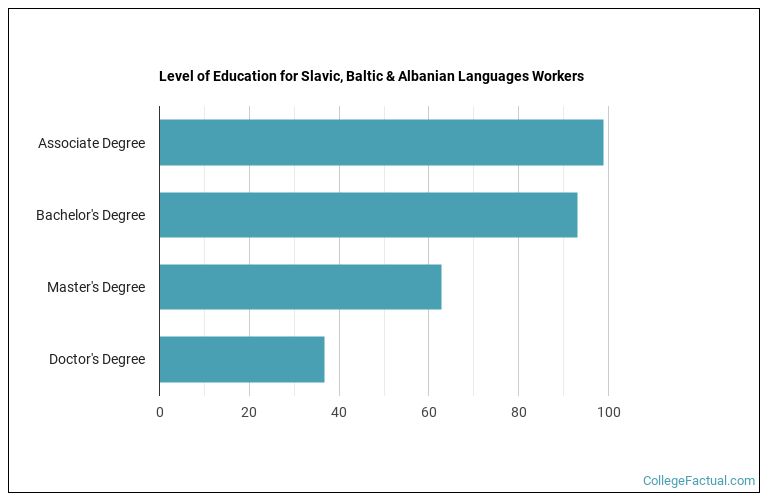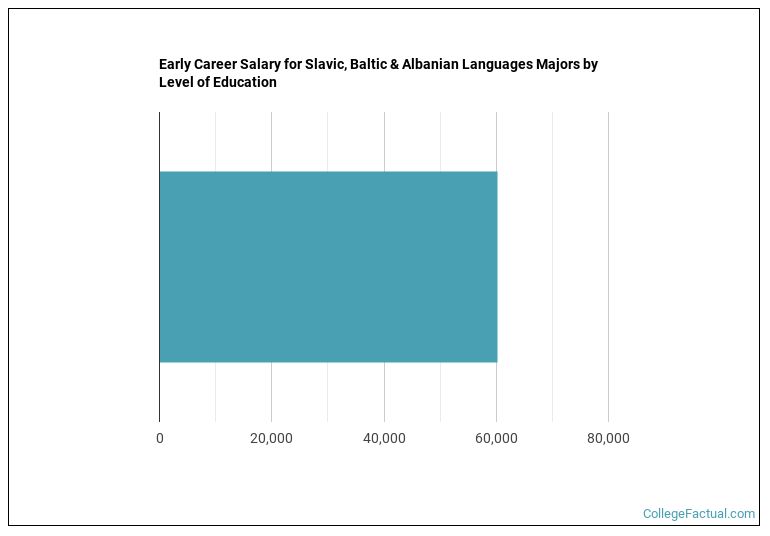 by our College Data Analytics Team
by our College Data Analytics TeamEastern Europe is a diverse place full of culture and a multitude of languages. A study in Slavic, Baltic and Albanian Languages will allow you an understanding of the different languages of the Eastern countries of Europe.
There are many different concentrations within this major. They include Baltic, Russian, Albanian, Czech, Polish, Slovak, Ukrainian, and Bosnian, Serbian and Croatian Languages and Literatures. After selecting one of these concentrations you will be instructed in philology, literature, dialects, and applications to business, science, and technology. While majoring in one of these concentrations, you will be taking courses in Beginner, Intermediate, and advanced language course, History of Poland, The Social Dynamics of Russian, History of Eastern Europe, and World Religion.
In 2021-2022, slavic, baltic & albanian languages was the 267th most popular major nationwide with 489 degrees awarded. Our 2025 Best Slavic, Baltic & Albanian Languages Schools ranking analyzes 6 of these schools to determine the best overall colleges for slavic, baltic & albanian languages students. Continue reading to check out one of our many unbiased rankings of slavic, baltic & albanian programs later in this article.
An ear for languages is a must when differentiating between different dialects, vocabulary and accents. Students should have an interest and appreciation for Eastern European culture and history.
To prepare for this major, students are advised to take are World Religion, Intro Language courses, World History, and World Government. There are opportunities for study abroad programs at some institutions. This would allow student to practice their lingual skills and experience the culture first hand.
New students will need to have completed high school or a GED program and each school will have their own minimum GPA and SAT/ACT test requirements. Specific slavic, baltic & albanian careers may require a certain level of degree attainment or additional certifications beyond that.
Slavic, Baltic & Albanian degree levels vary. You can get anything from a in slavic, baltic & albanian languages to the highest slavic, baltic & albanian degree, a . Depending on the slavic, baltic & albanian languages degree you choose, obtaining your diploma can take anwhere from 1 to 4+ years.
| Degree | Credit Requirements | Typical Program Length |
|---|---|---|
| Associate Degree | 60-70 credits | 2 years |
| Bachelor’s Degree | 120 credits | 4 years |
| Master’s Degree | 50-70 credits | 1-3 years |
| Doctorate | Program required coursework including thesis or dissertation | At least 4 years |
A doctor's degree is the most common level of education achieved by those in careers related to slavic, baltic & albanian, with approximately 36.7% of workers getting one. Find out other typical degree levels for slavic, baltic & albanian workers below.
| Level of Education | Percentage of Workers |
|---|---|
| Doctoral Degree | 37.8% |
| Bachelor’s Degree | 30.1% |
| Master’s Degree | 21.7% |
| Associate’s Degree (or other 2-year degree) | 5.6% |
| Post-Master’s Certificate | 4.3% |
Most workers in slavic, baltic & albanian have at least a master's degree. See the chart below for the most common degree level workers in slavic, baltic & albanian languages have received.

This of course varies depending on which slavic, baltic & albanian career you choose.
Majoring in Slavic, Baltic & Albanian Languages can lead to many different career opportunities. If you are interested in teaching, you could find work in Postsecondary and Adult Education. You would have the opportunity to teach Slavic, Baltic or Albanian dialect, along with culture and history. Another option is to become a translator, which are currently in high demand. If you are interested in Foreign Service, you can become a Foreign Service Officer. These officers endorse American business and political interest and give information and aid about their countries to the U.S policymakers. They arrange cultural exchanges, and help Americans travel abroad.
Want a job when you graduate with your slavic, baltic & albanian degree? Slavic, Baltic & Albanian Languages careers are expected to grow 15.7% between 2016 and 2026.
The following options are some of the most in-demand careers related to slavic, baltic & albanian languages.
| Occupation Name | Projected Jobs | Expected Growth |
|---|---|---|
| Interpreters and Translators | 80,300 | 17.7% |
| Foreign Language and Literature Professors | 39,100 | 11.7% |
Recently graduated slavic, baltic & albanian languages students earned an average of $60,240 in <nil>. Earnings can range from as low as $60,240 to as high as $60,240. As you might expect, salaries for slavic, baltic & albanian graduates vary depending on the level of education that was acquired.

Salaries for slavic, baltic & albanian languages graduates can vary widely by the occupation you choose as well. The following table shows the top highest paying careers slavic, baltic & albanian grads often go into.
| Occupation Name | Median Average Salary |
|---|---|
| Foreign Language and Literature Professors | $79,160 |
| Interpreters and Translators | $55,230 |
With over 272 different slavic, baltic & albanian degree programs to choose from, finding the best fit for you can be a challenge. Fortunately you have come to the right place. We have analyzed all of these schools to come up with hundreds of unbiased slavic, baltic & albanian school rankings to help you with this.
One of 18 majors within the Foreign Languages & Linguistics area of study, Slavic, Baltic & Albanian Languages has other similar majors worth exploring.
| Major | Annual Graduates |
|---|---|
| Russian Language & Literature | 364 |
| Slavic Language & Literature | 123 |
| Polish Language & Literature | 2 |
| Related Major | Annual Graduates |
|---|---|
| Romance Languages | 13,644 |
| Linguistics & Comparative Literature | 8,146 |
| American Sign Language | 2,671 |
| East Asian Languages | 2,319 |
| Classical Languages & Literature | 1,407 |
Image Credit: By Creatorspages under License More about our data sources and methodologies.